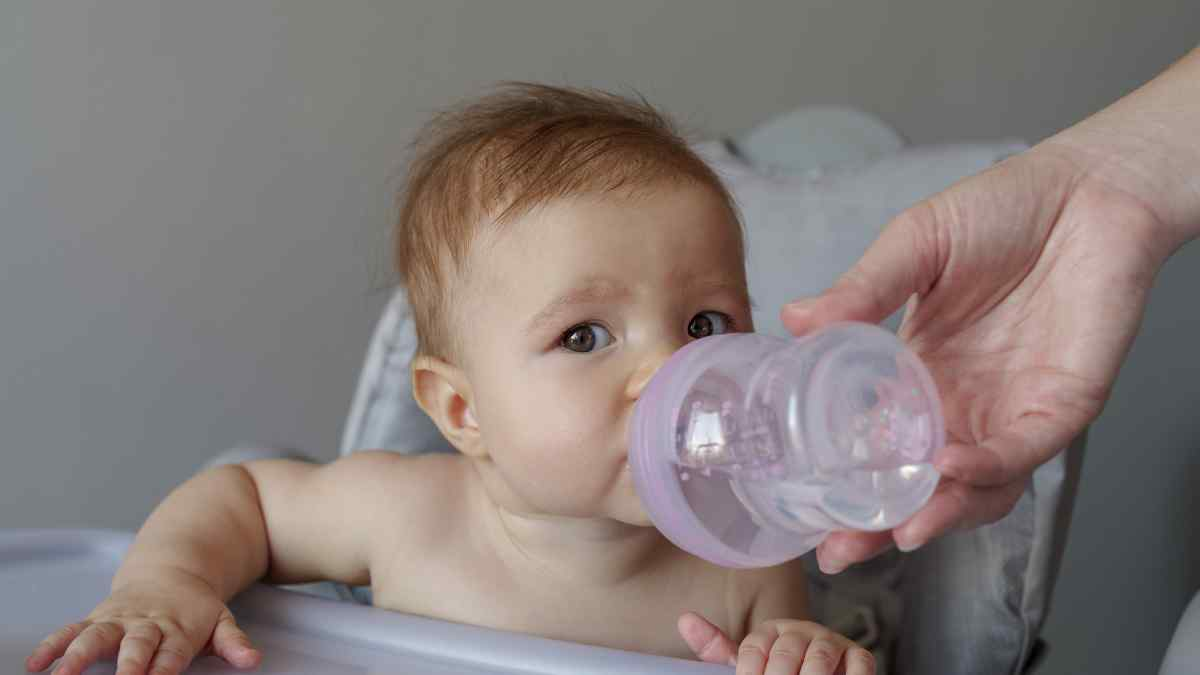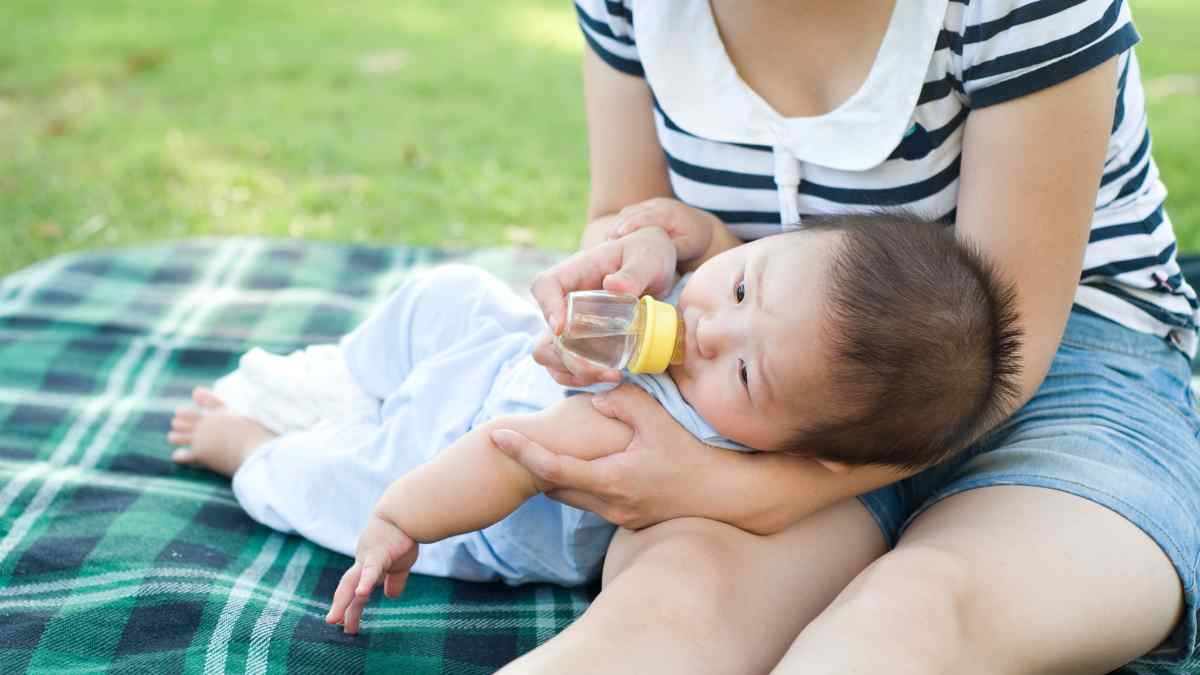As the saying goes, “Water is life.” But when it comes to our little ones, especially those energetic, always-on-the-move babies, understanding hydration needs can be both crucial and a tad bit complex. Babies, with their rapid growth and development, have unique fluid requirements that differ significantly from adults. Their little bodies can be more susceptible to dehydration, particularly when they’re active.
Yet, diving into the world of baby hydration presents a plethora of questions for parents: When should we introduce water? How much milk is enough? Are juices a yay or a nay? This comprehensive guide aims to shed light on these questions and more, ensuring your active baby stays happily hydrated. Let’s embark on this refreshing journey of understanding, one drop at a time.

Recognizing the Signs of Dehydration
Dehydration occurs when a child’s body loses more fluids than they take in, affecting their body temperature, energy levels, and overall health. Young children, especially those engaged in vigorous exercise or physical activity, can become dehydrated more easily. Recognizing early signs can make a world of difference.
Signs Your Child Might Be Dehydrated
1. Dry or Sticky Mouth: This is often the first noticeable sign. When your child complains of asticky mouth or is visibly parched, it’s essential to make sure they start drinking water immediately. Keep a water bottle handy throughout the day to encourage sips frequently.
2. Fewer Wet Diapers: For infants, fewer wet diapers (specifically, less than six in 24 hours) can be an alarming sign. While older kids don’t use diapers, monitoring how much water they pass can still provide insights. This is where the importance of hydrating foods, like fruits and vegetables, comes in—foods such as iceberg lettuce or whole fruits can help in maintaining healthy hydration.
3. No Tears When Crying: An emotional moment without tears is another red flag. Children, especially those below 3 years, express a lot through crying. No tears can be a tell-tale sign of mild dehydration.
4. Sunken Soft Spot on the Head: This is particularly concerning for infants up to a year old. If the soft spot appears sunken, it could indicate serious dehydration. Parents should contact a children’s hospital or pediatrician immediately.
5. Dark Yellow Urine: Light yellow signifies a well-hydrated body, but a dark yellow indicates dehydration. Make sure your child drink enough throughout the day—aim for a goal of 5 cups for children 4 to 8 years old, and 8 cups for older kids.
6. Sleepiness or Irritability: If your usually active child seems unusually sleepy or irritable, check other symptoms to determine if dehydration is the cause.
Hydration Solutions and Tips
– Breast Milk or Formula: For infants below 6 months, breast milk or formula should be their primary source of hydration. The American Academy of Pediatrics recommends exclusive breastfeeding up to 6 months. Beyond that, introduce water and hydrating solids to complement breast milk or formula.
– Drinking Water: From 6 months onwards, make drinking water a habit. Offer water in a fancy cup or infuse water with fresh fruit for older kids to make it appealing. Tap water is an economical choice, while bottled water can be handy on the go.
– Sports Drinks & Sugary Beverages: These aren’t always ideal for children. Sugary drinks can lead to tooth decay, while many sports drinks have too much sugar. If your child is dehydrated from vigorous exercise, consider an oral rehydration solution, but always consult a pediatrician.
– Hydrating Foods: Beyond drinking water, foods like fruits and vegetables are great. You can even create your own popsicles using popsicle molds with fresh fruit juices, avoiding extra sugars.

Introduction to Water
Having highlighted the essential signs of dehydration in the previous section, it’s pivotal to dive deeper into a key component of healthy hydration: water. It’s the primary drink that keeps us hydrated, maintains a healthy weight, and helps ensure our body functions properly. But for our little ones, there are specific guidelines to bear in mind. Introducing water at the right time and in appropriate quantities is essential for their well-being.
When to Introduce Water to Your Baby
– The Right Timing: According to the American Academy of Pediatrics, babies should exclusively rely on breast milk or formula for the first six months. Only after reaching this age milestone, it’s recommended to start incorporating plain water into a child’s fluid intake.
– The Dangers of Too Early: Offering water before six months can lead to a condition called water intoxication. Their kidneys aren’t mature enough to process a large amount of water. This can lead to severe dehydration and an imbalance in their body’s electrolytes, which can be life-threatening and might require a trip to a children’s hospital.
Guiding the Flow: How Much Water is Right?
– Post Six Months: Once your child hits the 6-month mark, it’s safe to introduce a few sips of cool water—especially during hot weather—to complement their regular feeds. Tap water, which is often fortified with fluoride, can be beneficial for their teeth.
– Growing Needs: As your baby continues to grow, their water intake needs increase. For babies between 6-12 months, a few sips from a water bottle every 20 minutes is adequate, particularly if they’re active. However, remember not to overdo it; their primary nutrition and hydration will still come from breast milk or formula.
– Toddlers and Older Children: As children cross their first birthday and start moving towards the two-year mark, they can drink more water. On average, toddlers can drink around 1-4 cups per day. The exact amount varies based on their activity level, size, and the climate they’re in.
Making Hydration Fun
Keeping kids hydrated doesn’t have to be a mundane task. Here are some creative ideas:
– Ice Cubes in Fun Shapes: Use molds to make ice cubes in different shapes. This can be a fun way for children to engage with their drink.
– Water Bottles with Markings: For older children, using water bottles with time markings can motivate them to drink enough fluids throughout the day.

Conclusion
Navigating the intricacies of hydration for active babies can seem daunting, but with the right knowledge and strategies, parents can ensure their young ones maintain optimal health. From understanding the first signs of dehydration to knowing when and how to introduce water, the journey is laden with vital milestones. As parents, we always want the best for our children, and ensuring they are well-hydrated is an integral aspect of their overall health.
Equipped with the insights from this guide, you can now feel confident in your ability to provide your child with the hydration they need to thrive, play, and explore the world with energy and zest. After all, our ultimate aim is to see our little ones bubbling with life and joy, just like the refreshing droplets of water they consume. Cheers to their health, growth, and ever-blossoming vibrancy!
Did this article help you? Please leave a comment below. If you have any questions, don’t hesitate to ask.



